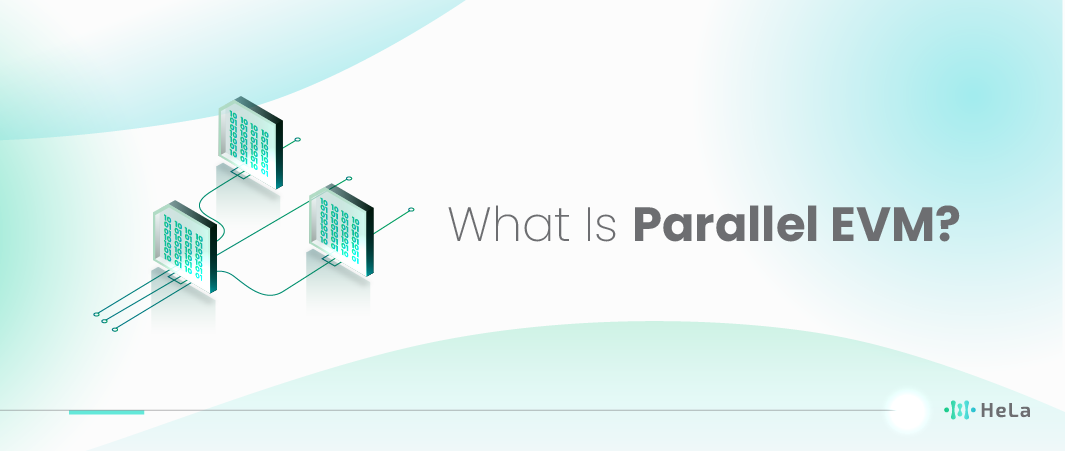In recent years, decentralized applications (dApps) have been on the rise, transforming various sectors such as finance, gaming, and supply chain management. However, as the demand for these dApps has grown, they have faced challenges in terms of scalability and efficiency. This is where the concept of Parallel EVM (Ethereum Virtual Machine) steps in. Parallel EVM has gained significant attention in the blockchain community as a potential solution to these issues.
So, what exactly is Parallel EVM? It’s a concept that aims to enhance the performance of dApps by allowing multiple transactions to be processed simultaneously, thus increasing the overall efficiency of blockchain networks. This innovation addresses the limitations that have hindered the growth of dApps, making them more practical for everyday use.
As Parallel EVM continues to gain importance in the blockchain ecosystem, it promises to unlock new possibilities for decentralized applications, making them faster, more scalable, and ultimately, more accessible to users. With Parallel EVM, the future of dApps looks brighter than ever before, offering the potential to revolutionize even more industries and create a seamless decentralized experience for users worldwide.
What is Parallel EVM?
Parallel EVM, or Parallel Ethereum Virtual Machine, is a cutting-edge technology aimed at addressing the scalability challenges faced by the Ethereum blockchain. As the popularity of decentralized applications (dApps) has grown, the Ethereum network has faced congestion issues and rising gas fees, making it less efficient and accessible for users. Parallel EVM proposes a fundamental shift in how smart contracts are executed on the Ethereum blockchain.
Traditionally, the Ethereum Virtual Machine (EVM) processes transactions and smart contracts one after the other, in a sequential manner. This means that when a user initiates a transaction or interacts with a dApp, they have to wait for it to be processed, leading to slower transaction times and higher fees during periods of network congestion.
Also Read: What are Crypto Farms? Separating Fact from Fiction
Parallel EVM, on the other hand, seeks to improve the performance of the Ethereum network by allowing multiple smart contracts to execute concurrently, or in parallel. This means that instead of waiting for one contract to complete before moving on to the next, the network can handle multiple contracts simultaneously, greatly increasing the throughput and overall efficiency of the system.
By introducing parallelism into the execution of smart contracts, Parallel EVM aims to reduce transaction processing times, lower gas fees, and enhance the overall user experience for dApp users. This innovation could potentially make Ethereum more competitive with other blockchain platforms and enable it to support a wider range of decentralized applications, from decentralized finance (DeFi) to non-fungible tokens (NFTs) and beyond.
Parallel EVM is part of ongoing efforts within the Ethereum community to implement Ethereum 2.0, a major upgrade that aims to transition the network from a proof-of-work (PoW) to a proof-of-stake (PoS) consensus mechanism and introduce various scalability solutions. These changes are essential for Ethereum to handle a growing user base and maintain its position as a leading blockchain platform in the decentralized ecosystem.
How Does Parallel EVM Work?

Parallel EVM (Parallel Ethereum Virtual Machine) is a groundbreaking technology designed to address the scalability issues of the Ethereum network. Ethereum, in its original form, operates on a single-threaded basis, which means that only one task can be executed at a time within the Ethereum Virtual Machine (EVM). This limitation has led to congestion and high gas fees during periods of high network activity.
To overcome these limitations, Parallel EVM leverages the concept of parallel processing. It accomplishes this by breaking down smart contracts into smaller, more manageable tasks that can be executed concurrently. These tasks, often referred to as “chunks” or “shards,” are essentially subsets of the original smart contract’s code and data.
Here’s a more detailed explanation of how Parallel EVM works:
- Task Decomposition: When a smart contract is submitted for execution, the Parallel EVM decomposes it into multiple smaller tasks or chunks. Each chunk contains a portion of the contract’s logic and data.
- Node Network: Parallel EVM relies on a distributed network of nodes, similar to the traditional Ethereum network. However, in this case, the nodes are equipped with the capability to execute tasks in parallel.
- Task Distribution: The decomposed tasks are then distributed across the network of nodes. Multiple nodes can work on different tasks simultaneously, as they don’t depend on each other’s results.
- Parallel Execution: Nodes execute their assigned tasks concurrently. This parallelization of tasks significantly reduces the time required for smart contract execution compared to the sequential execution in the traditional Ethereum network.
- Synchronization: Once all tasks are executed, the results are synchronized and combined to produce the final output of the smart contract. This final output is then recorded on the Ethereum blockchain.
By distributing the workload across multiple nodes and allowing them to work in parallel, Parallel EVM significantly enhances the overall throughput and scalability of the Ethereum network. It reduces congestion, lowers gas fees, and makes it possible to process a larger number of transactions and smart contract interactions simultaneously.
Parallel EVM is one of the innovative solutions aimed at improving Ethereum’s scalability and performance, making it more capable of handling the growing demand for decentralized applications (DApps) and smart contracts on the blockchain. This technology represents a significant step forward in addressing the limitations of the traditional Ethereum network.
Benefits of Parallel EVM
Parallel EVM (Parallel Ethereum Virtual Machine) is a technology that aims to improve the scalability and performance of decentralized applications (dApps) built on the Ethereum blockchain. It achieves this by introducing parallel processing capabilities into the Ethereum network. Here are some key benefits of Parallel EVM:
Enhanced Scalability
Parallel EVM is a critical solution to address Ethereum’s long-standing scalability challenges. Ethereum’s original single-threaded execution model limited the number of transactions and smart contracts that could be processed simultaneously. With Parallel EVM, the network can execute multiple transactions and smart contracts concurrently. This not only reduces network congestion but also ensures that Ethereum can handle a growing number of users and dApps without compromising performance.
Increased Throughput
Parallel EVM significantly boosts the network’s throughput. Ethereum’s base layer has struggled with limited transaction processing capacity, resulting in slow confirmation times during peak periods. By allowing parallel execution, Parallel EVM improves the Ethereum network’s transaction processing speed, enabling a higher number of transactions to be confirmed per second. This is essential for supporting dApps with high transaction volumes, such as decentralized exchanges and gaming platforms.
Improved User Experience
Slow confirmation times and high gas fees have been pain points for Ethereum users. Parallel EVM addresses these issues by reducing transaction confirmation times and lowering gas fees. Users can enjoy a smoother and more efficient experience when interacting with dApps, which is crucial for attracting and retaining a broader user base.
Lower Gas Costs
Gas costs have been a significant barrier to entry for many users on the Ethereum network. Parallel EVM alleviates this problem by optimizing gas usage and reducing the cost of executing smart contracts. This lower cost of operation encourages more users to participate in the Ethereum ecosystem, fostering greater adoption of dApps and decentralized finance (DeFi) applications.
Enhanced Developer Flexibility
Parallel EVM provides developers with greater flexibility when designing and deploying smart contracts. They can create more complex and resource-intensive applications without concerns about network limitations. This increased freedom encourages innovation within the Ethereum ecosystem, potentially leading to the development of novel and sophisticated dApps.
Network Resilience
Parallel EVM enhances the Ethereum network’s resilience by distributing computational workloads. This means that even during periods of high network congestion or in the face of potential attacks, the Ethereum network can continue to function efficiently. This resilience is essential for maintaining the integrity and security of the blockchain.
Compatibility with Existing EVM
Parallel EVM is designed to maintain compatibility with the existing Ethereum Virtual Machine (EVM). This ensures a smooth transition for developers and dApps migrating to the new parallel processing system. Developers can build upon their existing knowledge and codebase while benefiting from the improved performance and scalability offered by Parallel EVM.
Parallel EVM is a groundbreaking development in the Ethereum ecosystem, addressing fundamental scalability and performance issues. Its benefits extend to both users and developers, making Ethereum more accessible, efficient, and resilient. As the blockchain industry continues to evolve, technologies like Parallel EVM are crucial for ensuring that Ethereum remains a competitive and attractive platform for decentralized applications and services.
The Growing Importance of Parallel EVM

In the ever-evolving landscape of blockchain and cryptocurrency, the demand for scalability and efficiency has become paramount. As the popularity of these technologies continues to soar, the limitations of traditional blockchain platforms like Ethereum have become increasingly apparent. To address these challenges, the concept of Parallel EVM (Parallel Ethereum Virtual Machine) has emerged as a promising solution, gaining significant traction among developers, projects, and the wider blockchain community.
The Ethereum network, renowned for its pioneering role in the blockchain space, has faced persistent scalability issues as it strives to accommodate a growing number of users and decentralized applications (dApps). As the Ethereum ecosystem expands, so does the congestion on its network, resulting in high gas fees and slower transaction processing times. These bottlenecks hinder the platform’s overall efficiency and usability, prompting the search for innovative solutions.
Parallel EVM represents a novel approach to enhance blockchain scalability and efficiency. It works by breaking down the traditional single-threaded execution of smart contracts into multiple parallel threads or shards, enabling simultaneous processing of transactions and contract executions. This approach has the potential to significantly increase the throughput of the Ethereum network and improve its overall performance, making it more competitive with other blockchain platforms.
The growing interest and adoption of Parallel EVM are driven by several factors:
- Scalability: Parallel EVM promises to alleviate Ethereum’s scalability issues by allowing multiple transactions and smart contracts to be processed simultaneously. This scalability enhancement is vital for accommodating the increasing demand for blockchain services and mitigating congestion.
- Reduced Gas Fees: High gas fees have been a persistent concern on the Ethereum network. Parallel EVM has the potential to reduce gas fees by optimizing resource allocation and transaction processing, making blockchain usage more cost-effective.
- Enhanced User Experience: Faster transaction confirmation times and lower costs can lead to a better user experience for both developers and end-users of dApps and DeFi platforms on Ethereum.
- Compatibility: Parallel EVM is designed to be compatible with existing Ethereum infrastructure, ensuring a smooth transition for developers and projects already operating on the network. This compatibility minimizes the friction associated with adopting new technology.
- Interoperability: The concept of Parallel EVM is not limited to Ethereum alone. It has the potential to be implemented on other blockchain platforms, fostering interoperability and collaboration within the broader blockchain ecosystem.
While Parallel EVM holds great promise, it is essential to note that its full implementation and deployment come with their own set of technical challenges and potential risks. Security, synchronization, and maintaining consensus across parallel chains are some of the complex issues that developers and researchers are actively addressing.
Implementations and Adoption

Several prominent blockchain projects are actively working on implementing Parallel EVM and rigorously testing its feasibility. These implementations are seen as a pivotal step towards enhancing the scalability and performance of their decentralized applications (dApps), ultimately aimed at attracting a broader user base.
One notable example of this ongoing effort is within the Ethereum ecosystem. Ethereum, the world’s leading smart contract platform, has been exploring various strategies to address its scalability challenges, and Parallel EVM has emerged as a promising solution. Ethereum 2.0, a significant upgrade to the network, is actively considering ways to incorporate parallel processing as a core feature. This demonstrates the industry’s recognition of the innovative concept behind Parallel EVM and its potential to address one of the most pressing issues in blockchain technology: scalability.
Also Read: Utility Token vs Security Token: Breaking Down The Essential Differences
The adoption of Parallel EVM is not limited to Ethereum alone. Other blockchain projects and networks are also taking a keen interest in this concept. They recognize that by implementing Parallel EVM, they can unlock substantial improvements in transaction throughput, reduce latency, and enhance the overall user experience on their platforms. As a result, the adoption of Parallel EVM is expected to have a significant impact on the blockchain industry as a whole, ushering in an era of faster, more efficient, and more scalable decentralized applications.
Conclusion
In conclusion, Parallel EVM represents a significant advancement in the world of decentralized applications and blockchain technology. By offering enhanced scalability, reduced gas costs, and improved user experiences, it has the potential to bridge the gap between current limitations and the growing demand for efficient dApps. As the blockchain ecosystem continues to evolve, we can expect to see increased adoption and implementations of Parallel EVM, further propelling the world of decentralized applications into the future.
With Parallel EVM on the horizon, decentralized applications are poised to become more accessible and efficient, ultimately ushering in a new era of innovation and growth in the blockchain industry. As developers and projects continue to explore this promising technology, we can look forward to a more scalable and user-friendly decentralized application ecosystem.
Disclaimer: The information provided by HeLa Labs in this article is intended for general informational purposes and does not reflect the company’s opinion. It is not intended as investment advice or recommendations. Readers are strongly advised to conduct their own thorough research and consult with a qualified financial advisor before making any financial decisions.

Joshua Soriano
I am a writer specializing in decentralized systems, digital assets, and Web3 innovation. I develop research-driven explainers, case studies, and thought leadership that connect blockchain infrastructure, smart contract design, and tokenization models to real-world outcomes.
My work focuses on translating complex technical concepts into clear, actionable narratives for builders, businesses, and investors, highlighting transparency, security, and operational efficiency. Each piece blends primary-source research, protocol documentation, and practitioner insights to surface what matters for adoption and risk reduction, helping teams make informed decisions with precise, accessible content.
- Joshua Soriano#molongui-disabled-link
- Joshua Soriano#molongui-disabled-link
- Joshua Soriano#molongui-disabled-link
- Joshua Soriano#molongui-disabled-link

